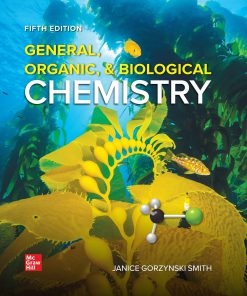Principles of General Organic and Biological Chemistry 11th Edition by Janice Gorzynski Smith ISBN 0073511153 9780073511153
$50.00 Original price was: $50.00.$25.00Current price is: $25.00.
Principles of General Organic and Biological Chemistry 11th Edition by Janice Gorzynski Smith – Ebook PDF Instant Download/Delivery: 0073511153 ,9780073511153
Full download Principles of General Organic and Biological Chemistry 11th Edition after payment

Product details:
ISBN 10: 0073511153
ISBN 13: 9780073511153
Author: Janice Gorzynski Smith
This new one-semester General, Organic, and Biological Chemistry textbook is written with the same student-focused, direct writing style that has been so successful in the Smith: Organic Chemistry and two-semester General, Organic, and Biological Chemistry texts. Smith writes with a bulleted approach that delivers need-to-know information in a succinct style for today’s students. Armed with an excellent macro-to-micro illustration program and many applications to biological, medical, consumer, and environmental topics, this book is a powerhouse of student learning.
Principles of General Organic and Biological Chemistry 11th Edition Table of contents:
1 Matter and Measurement
1.1 Chemistry—The Science of Everyday Experience
1.2 States of Matter
1.3 Classification of Matter
1.4A: The Metric System
1.4C: Measuring Mass
1.5 Significant Figures
1.5A: Determining the Number of Significant Figures
1.5B: Using Significant Figures in Multiplication and Division
1.5C: Using Significant Figures in Addition and Subtraction
1.6 Scientific Notation
1.7A: Conversion Factors
1.7B: Solving a Problem Using One Conversion Factor
1.7C: Solving a Problem Using Two or More Conversion Factors
1.8 FOCUS ON HEALTH & MEDICINE: Problem Solving Using Clinical Conversion Factors
1.9 Temperature
1.10A: Density
1.10B: Specific Gravity
KEY CONCEPTS
UNDERSTANDING KEY CONCEPTS
ADDITIONAL PROBLEMS
ANSWERS TO SELECTED PROBLEMS
2 Atoms and the Periodic Table
2.1 Elements
2.1B: FOCUS ON THE HUMAN BODY: The Elements of Life
2.1C: Compounds
2.2 Structure of the Atom
2.3A: Isotopes, Atomic Number, and Mass Number
2.3C: FOCUS ON HEALTH & MEDICINE: Isotopes in Medicine
2.4 The Periodic Table
2.4B: Characteristics of Groups 1A, 2A, 7A, and 8A
2.4C: The Unusual Nature of Carbon
2.5 Electronic Structure
2.6A: First-Row Elements (Period 1)
2.6B: Second-Row Elements (Period 2)
2.6C: Other Elements
2.7A: Relating Valence Electrons to Group Number
2.7B: Electron-Dot Symbols
2.8A: Atomic Size
2.8B: Ionization Energy
KEY CONCEPTS
UNDERSTANDING KEY CONCEPTS
ADDITIONAL PROBLEMS
BEYOND THE CLASSROOM
ANSWERS TO SELECTED PROBLEMS
3 Ionic and Covalent Compounds
3.1 Introduction to Bonding
3.2A: Cations and Anions
3.2B: Relating Group Number to Ionic Charge for Main Group Elements
3.2D: FOCUS ON THE HUMAN BODY: Important Ions in the Body
3.3 Ionic Compounds
3.3A: Formulas for Ionic Compounds
3.3B: FOCUS ON HEALTH & MEDICINE: Ionic Compounds in Consumer Products
3.4A: Naming Cations
3.4C: Naming Ionic Compounds with Cations from Main Group Metals
3.4D: Naming Ionic Compounds Containing Metals with Variable Charge
3.4E: Writing a Formula from the Name of an Ionic Compound
3.5 Physical Properties of Ionic Compounds
3.6 Polyatomic Ions
3.6B: Naming Ionic Compounds with Polyatomic Ions
3.6C: FOCUS ON HEALTH & MEDICINE: Useful Ionic Compounds
3.7 Covalent Bonding
3.8A: Drawing Lewis Structures
3.9 Naming Covalent Compounds
3.10 Molecular Shape
3.10C: Four Groups Around an Atom
3.11 Electronegativity and Bond Polarity
3.12 Polarity of Molecules
KEY CONCEPTS
ADDITIONAL PROBLEMS
CHALLENGE PROBLEMS
ANSWERS TO SELECTED PROBLEMS
4 Energy and Matter
4.1 Energy
4.1B: FOCUS ON THE HUMAN BODY: Energy and Nutrition
4.2 The Three States of Matter
4.3 Intermolecular Forces
4.3B: Dipole–Dipole Interactions
4.3C: Hydrogen Bonding
4.4 Boiling Point and Melting Point
4.5 Energy and Phase Changes
4.5A: Converting a Solid to a Liquid
4.5B: Converting a Liquid to a Gas
4.5C: Converting a Solid to a Gas
4.6 Heating and Cooling Curves
KEY CONCEPTS
UNDERSTANDING KEY CONCEPTS
ADDITIONAL PROBLEMS
ANSWERS TO SELECTED PROBLEMS
5 Chemical Reactions
5.1A: General Features
5.1B: Writing Chemical Equations
5.2 Balancing Chemical Equations
5.3 The Mole and Avogadro’s Number
5.4A: Molar Mass
5.4B: Relating Grams to Moles
5.5 Mole Calculations in Chemical Equations
5.6A: Converting Moles of Reactant to Grams of Product
5.6B: Converting Grams of Reactant to Grams of Product
5.7A: General Features of Oxidation–Reduction Reactions
5.7B: Examples of Oxidation–Reduction Reactions
5.7C: FOCUS ON HEALTH & MEDICINE: Pacemakers
5.8A: Heat of Reaction
5.8B: Energy Diagrams
5.9A: How Concentration and Temperature Affect Reaction Rate
5.9B: Catalysts
5.10 FOCUS ON THE HUMAN BODY: Body Temperature
KEY CONCEPTS
UNDERSTANDING KEY CONCEPTS
ADDITIONAL PROBLEMS
ANSWERS TO SELECTED PROBLEMS
6 Gases
6.1B: Gas Pressure
6.1C: FOCUS ON HEALTH & MEDICINE: Blood Pressure
6.2 Boyle’s Law Relating Gas Pressure and Volume
6.3 Charles’s Law Relating Gas Volume and Temperature
6.4 Gay–Lussac’s Law Relating Gas Pressure and Temperature
6.5 The Combined Gas Law
6.6 Avogadro’s Law Relating Gas Volume and Moles
6.7 The Ideal Gas Law
6.8 Dalton’s Law and Partial Pressures
6.9A: The Ozone Layer
6.9B: Carbon Dioxide and Global Warming
KEY EQUATIONS—THE GAS LAWS
UNDERSTANDING KEY CONCEPTS
ADDITIONAL PROBLEMS
ANSWERS TO SELECTED PROBLEMS
7 Solutions
7.1 Introduction
7.2 Solubility—General Features
7.3A: Temperature Effects
7.3B: Pressure Effects
7.4A: Weight/Volume Percent
7.4B: Volume/Volume Percent
7.4C: Using a Percent Concentration as a Conversion Factor
7.4D: Parts Per Million
7.5 Concentration Units—Molarity
7.6 Dilution
7.7A: Osmotic Pressure
7.7B: FOCUS ON THE HUMAN BODY: Osmosis and Biological Membranes
7.7C: FOCUS ON HEALTH & MEDICINE: Dialysis
KEY EQUATIONS—CONCENTRATION
UNDERSTANDING KEY CONCEPTS
ADDITIONAL PROBLEMS
ANSWERS TO SELECTED PROBLEMS
People also search for Principles of General Organic and Biological Chemistry 11th Edition:
principles of gen org & bio chem w/alek
principles of organic chemistry and biochemistry
what is general organic and biological chemistry
principles of general organic & biological chemistry with aleks
principles of general chemistry
Tags: Janice Gorzynski Smith, General Organic, Biological Chemistry
You may also like…
Chemistry - Organic Chemistry
General, Organic, & Biological Chemistry 5th Edition Janice Gorzynski Smith
Chemistry - Organic Chemistry
Organic Chemistry Student Study Guide Solution 6th Edition Janice Gorzynski Smith
Uncategorized
Chemistry
General, Organic, and Biological Chemistry: Structures of Life 6th Edition Karen Timberlake
Chemistry - Chemistry - General & Miscellaneous
Chemistry - History of Chemistry
Chemistry - Chemistry - General & Miscellaneous
Fundamentals of General Organic and Biological Chemistry Eighth Edition John E. Mcmurry
Chemistry - Chemistry - General & Miscellaneous











